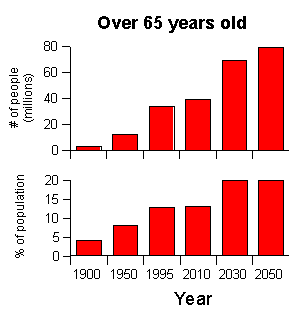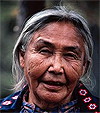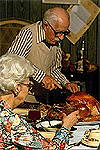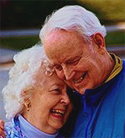| In the last 100 years, there has been a dramatic increase in the population of elderly (age 65 years and older) people. As shown in the graph, elderly people in the US made up only 4.1% of the population in 1900, but 8.1% in 1950 and 12.8% in 1995. By 2050, it is estimated that 20% of the population will be 65 years old or older. This increase in the elderly population and the high incidence of age-related neurological disorders make it important to understand how the human brain ages. |  Data from Malmgren, R., in Textbook of Geriatric Neuropsychiatry, 2000. |
To investigate the changes that the brain undergoes during aging, neuroscientists use brain imaging methods to observe the anatomy and physiology of the living brain. Scientists can also study autopsy specimens to investigate how the brain changes over time.
Brain Changes

- Enlargement of the ventricular system: as people get older, the volume of the ventricles (the spaces in the brain that contain cerebrospinal fluid) increases. It is thought that this enlargement occurs because cells surrounding the ventricles are lost.
- Widening of sulci (the grooves) on the surface of the brain.
- Reduced brain weight and brain volume: these changes are probably caused by the loss of neurons. Reductions in the size of many areas of the cerebral cortex have been reported.
- Neurological disorders: brain disorders such as Alzheimer's disease, Parkinson's disease and stroke are more common in the elderly.
Changes in the Senses
Vision 
- Lens: proteins in the lens change with age and the elasticity of the lens is reduced. Therefore, many elderly individuals have trouble focusing their eyes. Exposure to ultraviolet light can also yellow the lens. Changes in the lens may affect color vision.
- Cornea: the cornea may become less transparent and more flat. This may cause images to appear distorted or blurred. There may also be a loss of color sensitivity to green, blue and violet shades.
- Pupil: changes in the autonomic nervous system alter the ability of older people to dilate the pupil. By age 70, the pupil may not dilate easily in low lighting conditions (Hampton, 1997).
- Cataracts: cloudy areas of the lens. Cataracts decrease the amount of light that passes through the lens and can bend light abnormally. The National Eye Institute estimates that more than 50% of Americans age 65 years and olderhave a cataract.
- Retina: the peripheral retina is thinner and contains fewer rods in older individuals.

- Other disorders of the eye common in the elderly: glaucoma, macular degeneration, presbyopia.
Olfaction
- Changes in the nasal mucosa, cribriform plate and air passages may contribute to impaired odor recognition.
- The amygdala and other brain areas involved with smell may be damaged in older individuals.
Taste
Impairment in the ability to taste may be caused by:
- Medications that the elderly need.
- Reductions in the number of taste buds.
- Dentures that cover taste buds on the soft palate.
Audition
Hearing loss in the elderly may result from:
- Ear wax build up.
- Stiffening of the tympanic membrane (eardrum).
- Atrophy of small ear muscles.
- Degeneration of hair cells and support cells in the cochlea.
- Stiffening of basilar membrane.
- Loss of nerve fibers leading from the cochlea to the brain.
- Loss of neurons in auditory areas of the brain.
Touch 
Age-related changes in the ability to perceive tactile stimuli may be due to:
- Loss of various receptors (for example, Meissner's and Pacinian corpuscles) in the skin.
- Reductions in the number of sensory fibers innervating the skin.
For more information on the aging nervous system, see:
- The American Psychiatric Press Textbook of Geriatric Neuropsychiatry, edited by C. E. Coffey, J. L. Cummings, Washington, DC: American Psychiatric Press, 2000.
- Hampton, J.K., Craven, R.F., and Heitkemper, M.M. The Biology of Human Aging, Dubuque: Wm. C. Brown, 1997.
- Hooper, C.R., Sensory and sensory integrative development, in Functional Performance in Older Adults, edited by B.R. Bonder and M.B. Wagner, Philadelphia: F.A. Davis Company, 2001, pp. 121-136.
Tidak ada komentar:
Posting Komentar